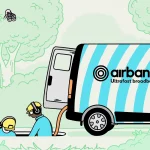Openreach Remove 35ft Poles from Exeter UK Street After Locals Moan
Openreach’s (BT) attempts to bring “full fibre” (FTTP) broadband services to the suburbs of Exeter (Devon) have been met with anger on Armstrong Avenue, where residents complained that the new 35ft telegraph poles are too tall, “ugly” and some also appear to be bent. Thankfully a solution has already been found.
In this case Armstrong Avenue is already quite well served by Fibre-to-the-Cabinet (FTTC / VDSL2) technology and Virgin Media’s ultrafast cable network. Instead Openreach were in the process of rolling out Fibre-to-the-Premises (FTTP) technology to this street as part of their on-going “Fibre First” programme (3 million premises by the end of 2020).
However not everybody is a fan of wooden telegraph poles and if you haven’t had them on your street before then their appearance may not go down well, although equally they are still a fairly common sight in many parts of the United Kingdom (a lot of cables run underground but doing that is often slower, more disruptive and more expensive).
Advertisement
According to DevonLive, locals were less than pleased after the new poles appeared just before Christmas. Apparently the operator notified the council on 11th December and the works began on 15th, taking only five days to complete (Permitted Development Rights). Ward councillor Percy Prowse said: “The contractors told me that the poles they were erecting were too big and excessive considering they [need] to hold one cable.”
Residents will at least be pleased to hear that Openreach has agreed to remove the poles and better yet, the area will still be getting FTTP.
A Spokesperson for Openreach said:
“In those small areas where there isn’t any existing infrastructure, we need to build brand new network, which can include poles. We look at ways of informing residents as early as possible about new infrastructure but retain the overall right to site poles to provide network where necessary.
We have worked closely with the Highways Agency and the local authority for all other relevant permissions.
We’ve listened to concerns from residents and Councillors regarding the new poles we recently erected and we absolutely agree that the poles in Armstrong Avenue aren’t in keeping with the local environment and we will remove them as quickly as possible.”
Under the new plan Openreach said they intend to pilot a “new” type of Micro Trenching technology that has been developed in Germany. Regular readers will know that Micro Trenching (i.e. digging a shallow and narrow trench at speed into the pavement for new cables) has been around for several years and is often used by civil engineers.
Hopefully the locals don’t find more reasons to complain when civil engineers turn up to block their driveways and slice through the local pavement. Well they did ask for it to go underground and in this case their wish has been granted, although in other areas such complaints have resulted in locals being left without access to faster broadband for longer than expected.
Advertisement
Mark is a professional technology writer, IT consultant and computer engineer from Dorset (England), he also founded ISPreview in 1999 and enjoys analysing the latest telecoms and broadband developments. Find me on X (Twitter), Mastodon, Facebook, BlueSky, Threads.net and Linkedin.
« Business Rates Deal Means Cash for West Sussex Gigabit Broadband UPDATE


















































Comments are closed